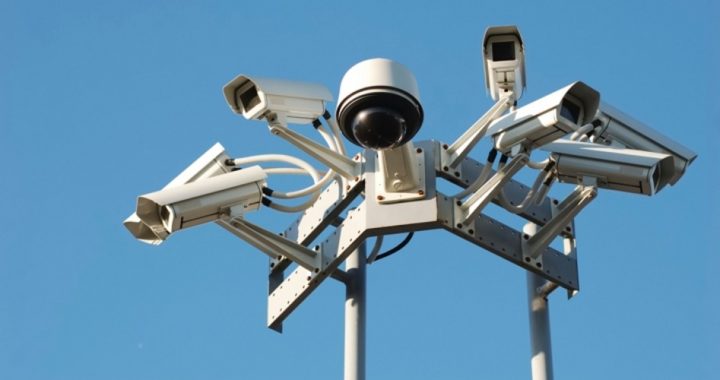
The surveillance state — ever on the rise since 9/11 — is making plans to grow even bigger and dig even deeper into the lives of American citizens. And in this recent push for growth, the federal behemoth has accomplices in state and local governments.
Using the tool of federal funding with strings attached, the surveillance hawks in the federal government are rapidly expanding the surveillance state. Case in point: As part of an expansion of the public transit system in Richmond, Virginia, the placement of more than 100 live surveillance cameras is part of the development of a 7.6-mile section of the Greater Richmond Transit Company’s (GRTC) bus route.
The project — GRTC Pulse — was developed and funded through a partnership between the U.S. Department of Transportation, the Virginia Department of Transportation, the City of Richmond, and Henrico County. According to CBS affiliate WTVR, the cameras — four at each of the route’s 26 stops — were required by the federal government as a condition of helping fund the project.
As the Tenth Amendment Center wrote:
The federal government is in the process of using America’s transportation system as a platform to create a massive surveillance network. A recent announcement by a municipal transit authority in Virginia sheds light on this plan and exposes how the feds develop partnerships with state and local governments, along with private organizations, to spy on millions of Americans.
The Greater Richmond Transit Company (GRTC) recently announced plans to install more than 100 live surveillance cameras at stops along a rapid transit line. According to a WTVR report, GRTC plans to install approximately four cameras at 26 Pulse stops along Broad Street. The system will be live 24 hours a day and directly connected to the city’s 911 facility.
WTVR reported: “Officials said the federal TIGER grant used to fund the half of the project required installation of the camera system, but privacy advocates said the large number of live cameras in public spaces creates a major privacy concern.”
Using a play from a dogeared page in the playbook, the surveillance comes packaged as a “public safety” measure. Carrie Rose Pace, director of communications for GRTC, said the system will allow quicker response times to any problems arising along the route. She told WTVR, “It’s pretty standard for all B.R.T. (bus rapid transit) or light rail type systems,” adding, “You want to have security cameras at the Pulse station platforms. It ensures that we can provide safe and responsive customer service for any need that happens at the platforms.” She also said most PULSE loading platforms will be outfitted with four cameras and that the system will be live 24 hours a day and will be connected to Richmond 911 call center.
The privacy advocates who have expressed concern about this include representatives of the ACLU of Virginia. The ACLU’s Bill Farrar aptly described it as government-sanctioned surveillance and said, “There’s very little evidence that this type of surveillance enhances public safety, and there is every reason to think that it inhibits people — that it causes us to behave differently than we would if we weren’t being watched.”
And while the “public safety” packaging appears to be having its desired effect on many (a spoonful of sugar helps the poison go down, too), it is obvious — at least to people such as Farrar — that the surveillance is the real point, not an unfortunate side effect. He said, “In practice, the use of these systems and the data they collect is almost always expanded, giving law enforcement more information than they need or should have about the personal lives of law-abiding people.”
The Tenth Amendment Center reports that a “2010 US Government Accountability Office report titled ‘Public Transit Information Sharing’ highlights the TSA and DHS’s role in creating a giant public transit surveillance network working through various partnerships. The report also reveals information sharing going on between local transit authorities, local law enforcement, the Department of Homeland Security and the TSA.” That report states:
Since the terrorist attacks of September 11, 2001, the federal government, including DHS, has taken a number of actions to enhance the security of transportation systems. These actions include improving information sharing with its critical sector stakeholders, which is highlighted in the 2008 Department of Homeland Security Information Sharing Strategy, as well as the 2009 National Infrastructure Protection Plan (NIPP). To help facilitate information sharing with the public transit industry, DHS and the Transportation Security Administration (TSA) have created and funded a number of mechanisms, including the Public Transportation Information Sharing and Analysis Center (PT-ISAC), which is administered by the American Public Transportation Association (APTA). The PT-ISAC was created under the direction of the Department of Transportation (DOT) in 2003 and is currently funded by TSA via DOT’s Federal Transit Administration (FTA). In addition to DHS, other federal agencies, such as the Department of Justice’s (DOJ) Federal Bureau of Investigation (FBI) and FTA, have also taken action to enhance their efforts to share security-related information with public and private stakeholders, including public transit agencies.
And while the APTA “is a nonprofit organization serving as an advocate for the advancement of public transportation programs and initiatives in the U.S.,” a “private company called IIT operates the PT-ISAC for the APTA.
So, the incestuous relationship between federal, state, and local governments, non-profit organizations, and private companies — all of whom have a vested interest in the burgeoning surveillance state — has brought America to a place that would have looked like a bad plot for a dystopian Sci-Fi movie just a few years ago: The comings and goings of an untold number of normal, everyday, law-abiding citizens are being digitally recorded and archived by a round-the-clock surveillance system. And the tie that binds it all together is the addictive nature of federal grants funded by “money” created out of thin air by an unaccountable system.
And they wonder why privacy advocates don’t trust them.




